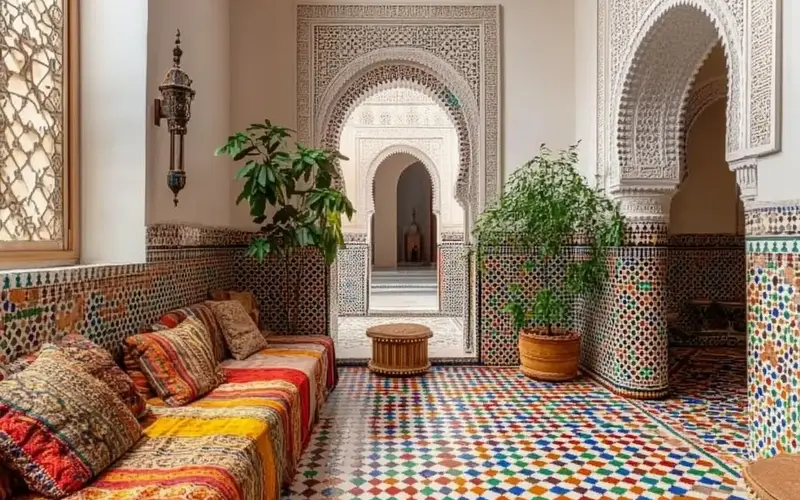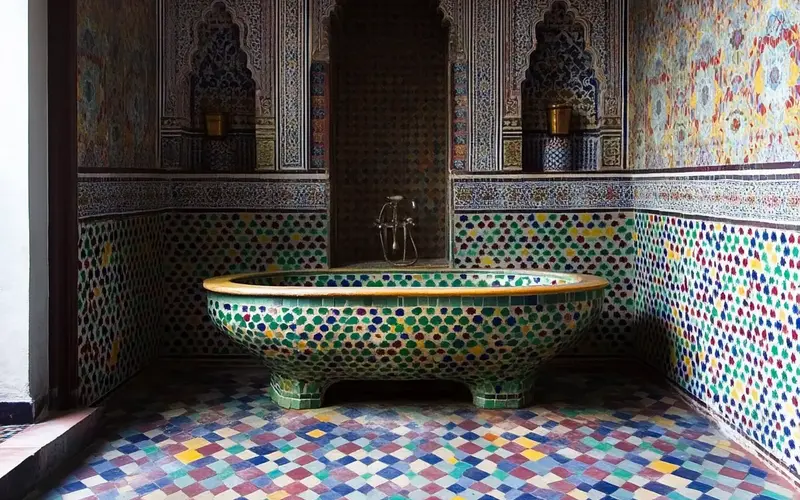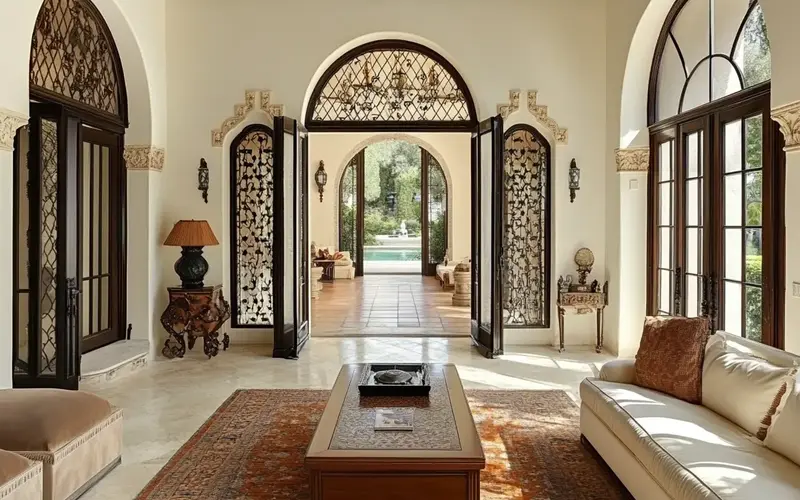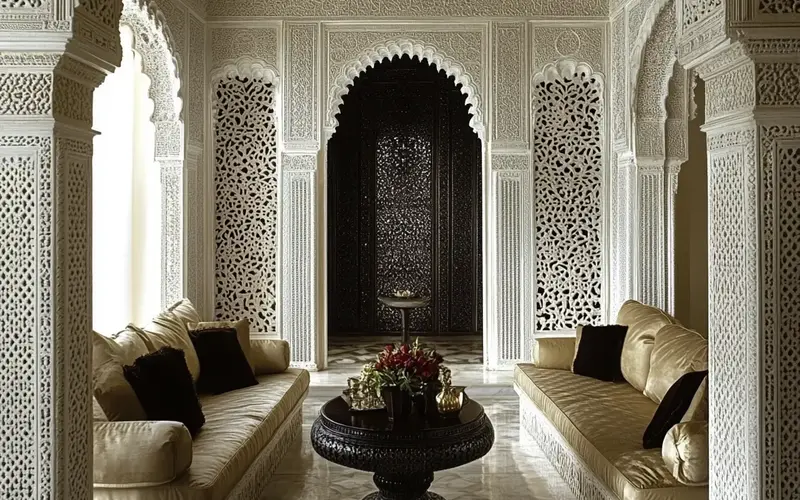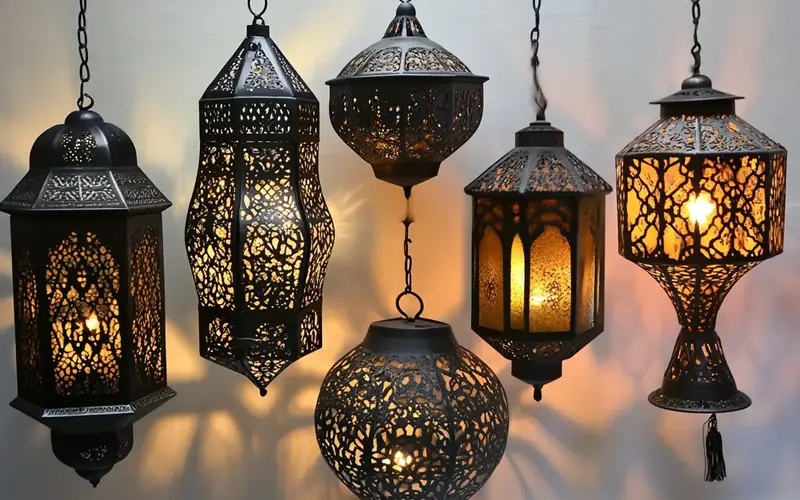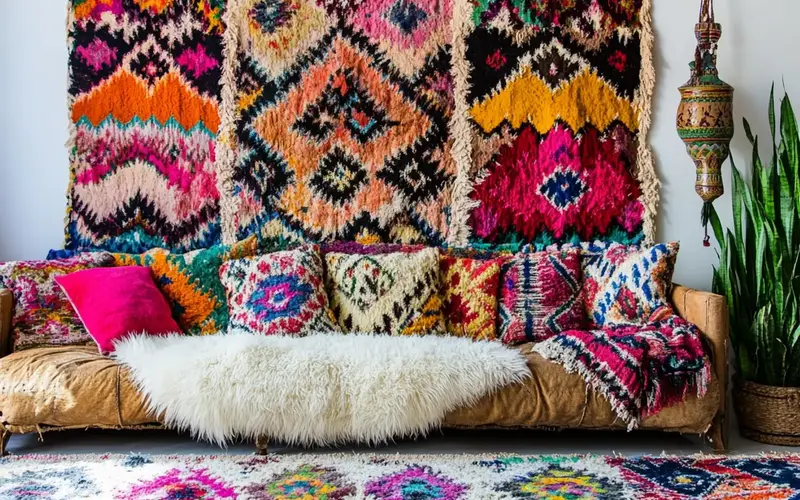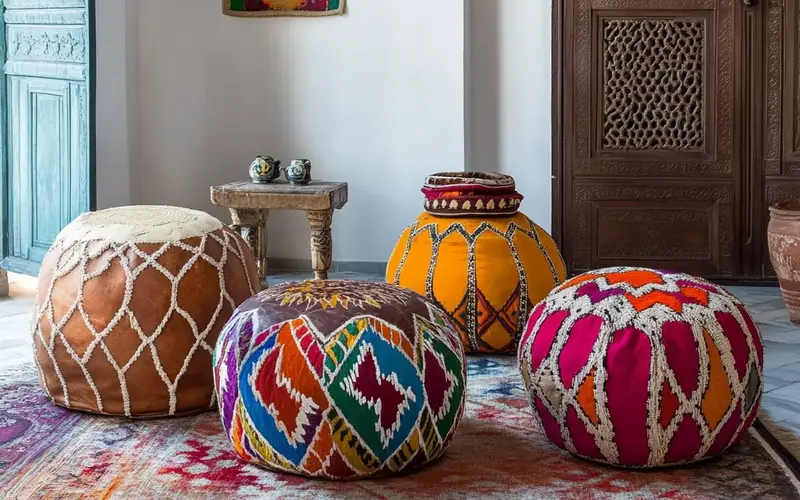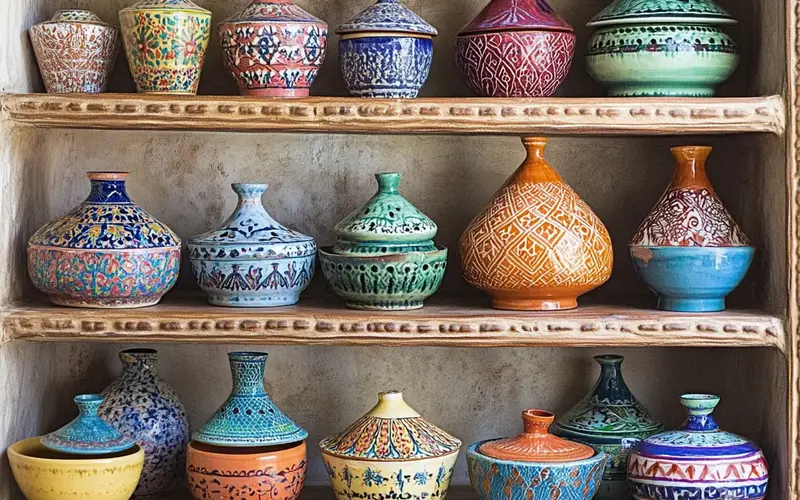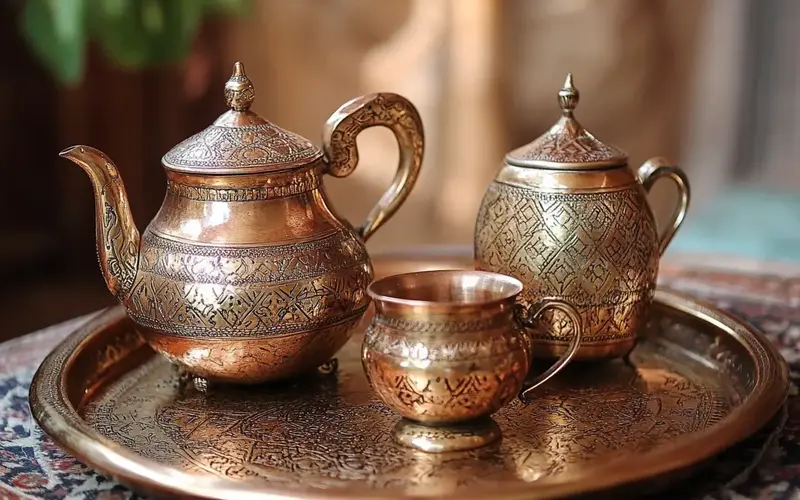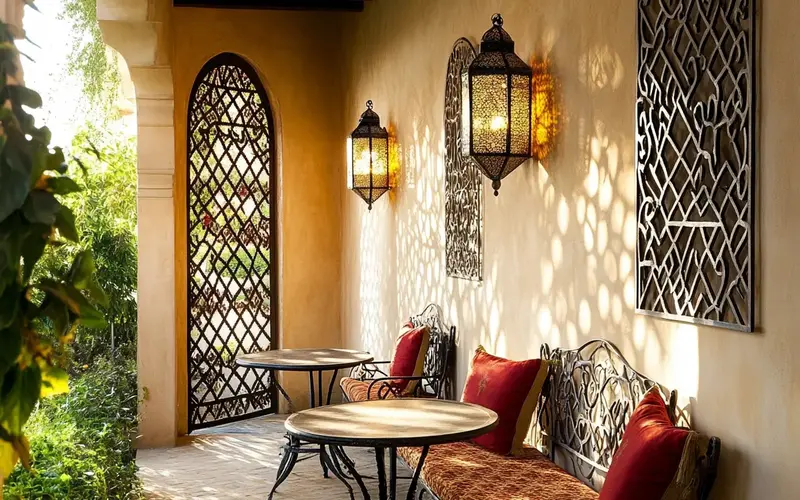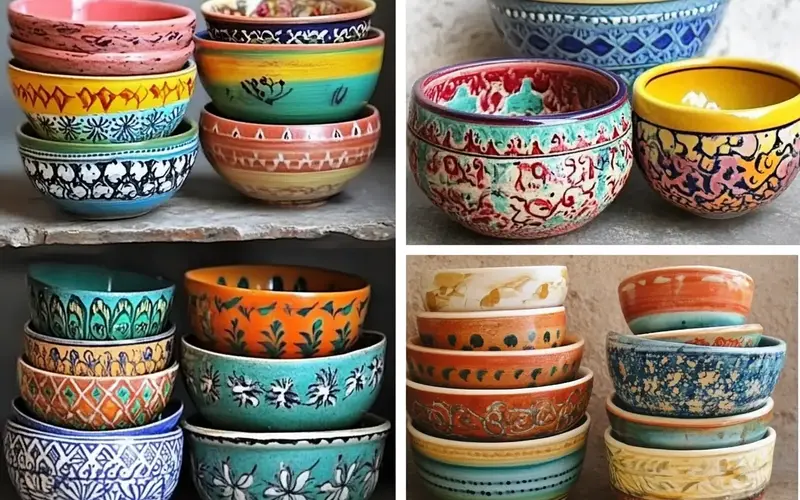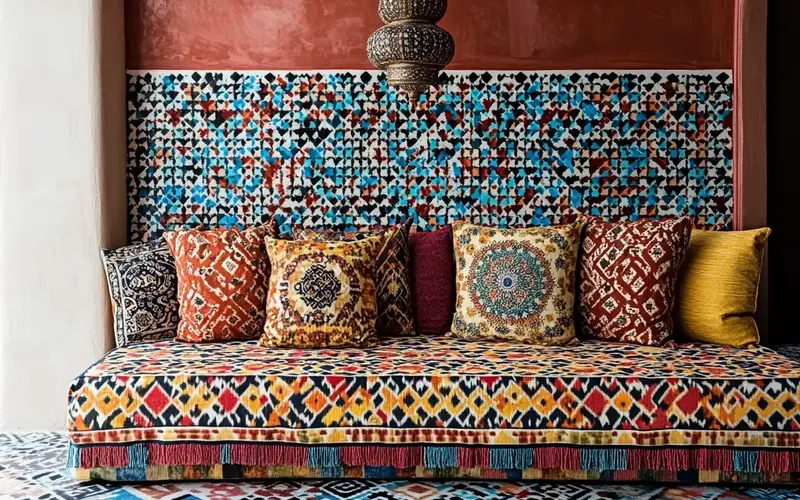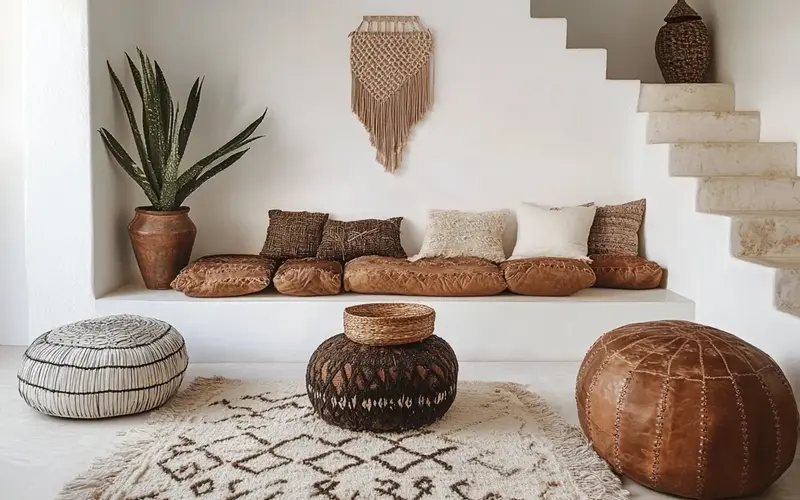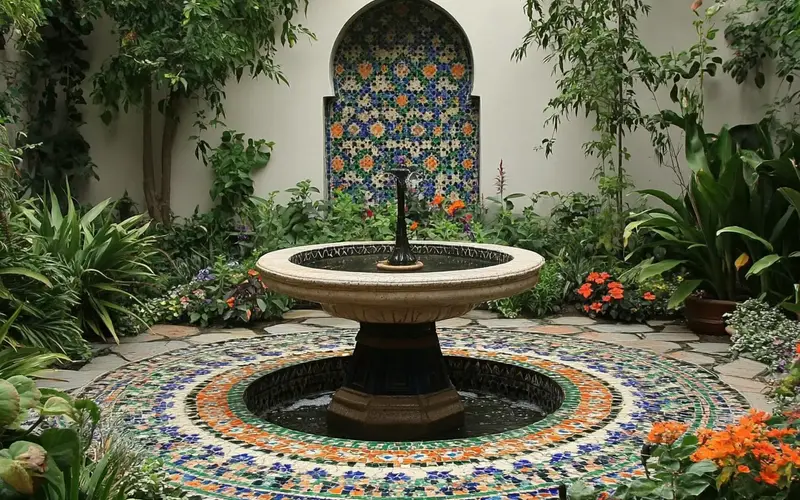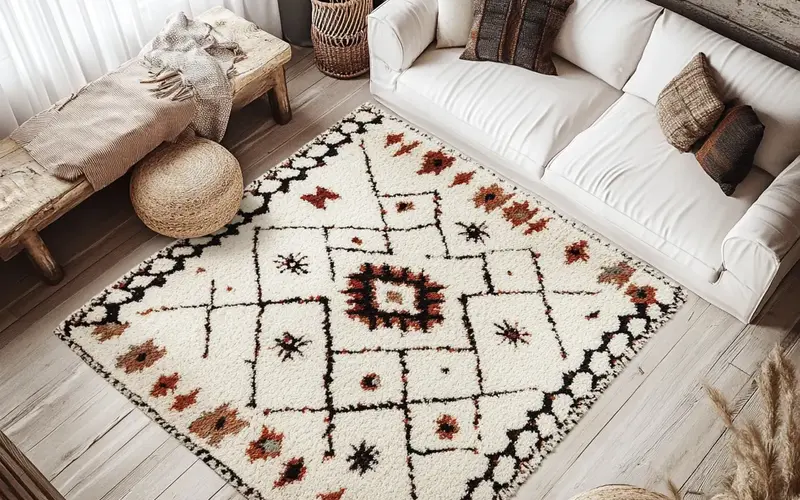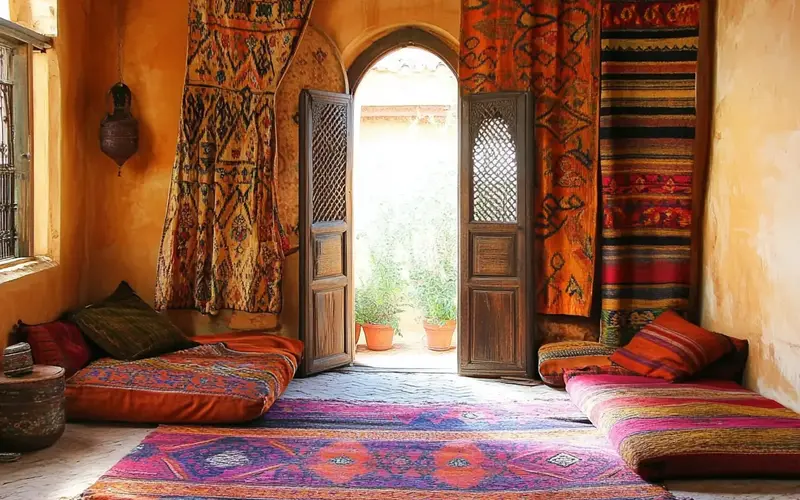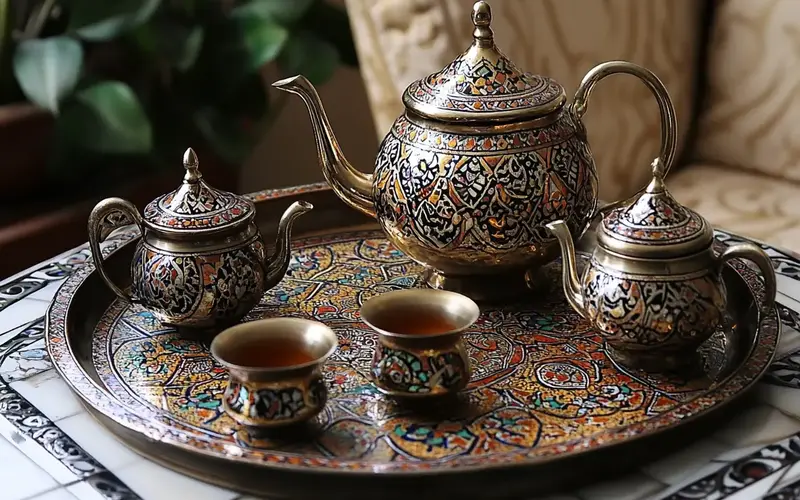Moroccan design is a captivating blend of vibrant colors, intricate patterns, and rich textures. Its style evokes a sense of warmth, exoticism, and timeless elegance. Incorporating Moroccan elements into your home decor can transform any space into a haven of unique beauty and cultural charm.
From the mesmerizing geometric patterns of Zellige tiles to the intricate carvings on wooden furniture, Moroccan design has a way of captivating the senses and transporting you to a faraway land.
1. Zellige Tiles:
Zellige tiles are the crown jewels of Moroccan design. These handcrafted mosaic tiles are renowned for their intricate geometric patterns and subtle color variations. Each tile is a work of art meticulously crafted by skilled artisans. Incorporating Zellige tiles into your home, whether on floors, walls, backsplashes or even as decorative accents on furniture, will instantly infuse your space with Moroccan authenticity.
Zellige tiles’ shimmering glaze and irregular edges create a captivating play of light and shadow, adding depth and dimension to any surface. Consider the Moroccan Mosaic & Tile House Zellige Tile Sample Pack to experience the beauty and versatility of these tiles firsthand.
2. Arches and Keyhole Archways:
Arches and keyhole archways are iconic architectural features that add a sense of grandeur and mystery to Moroccan homes. These graceful curves create a visual flow and draw the eye upward, making spaces feel larger and more open. You can incorporate arches into doorways, windows, or decorative wall elements.
The Arched Mirror can be a stunning focal point in any room, reflecting light and adding a touch of Moroccan elegance. With their distinctive shape, keyhole archways can frame a beautiful view or create a sense of intrigue as you pass through them. Imagine a keyhole archway leading to a cozy reading nook or a vibrant Moroccan-inspired patio.
3. Intricate Carvings and Plasterwork:
Moroccan craftsmanship is renowned for its intricate carvings and plasterwork. These delicate and ornate details can be found on walls, ceilings, furniture, and decorative screens. The intricate patterns and motifs often tell stories or represent cultural symbols, adding a layer of meaning to your decor.
Consider the Moroccan Hand Carved Wood Room Divider to create a sense of privacy and add a touch of exotic beauty to your space. Plasterwork, with its intricate designs and textures, can transform a plain wall or ceiling into a work of art. Imagine a bedroom with a beautifully carved headboard or a living room with a stunning plaster ceiling medallion.
4. Lanterns and Lighting:
Moroccan lanterns are more than just light sources; they are works of art. Crafted from metal with intricate cutouts, these lanterns cast beautiful patterns of light and shadow, creating a warm and inviting ambiance. Hang them from ceilings, place them on tables, or use them to illuminate outdoor spaces.
The Moroccan Hanging Lantern will add a touch of magic to any room, transporting you to the bustling souks of Marrakech. You can also incorporate Moroccan-inspired lighting fixtures, such as chandeliers or wall sconces, to create a cohesive and enchanting atmosphere throughout your home.
5. Colorful Textiles and Rugs:
Moroccan textiles and rugs are a feast for the eyes. Handwoven with vibrant colors and geometric patterns, it adds warmth, texture, and a sense of cultural richness to any space. Use them as floor coverings, wall hangings, or to add a touch of comfort to furniture.
The Moroccan Berber Rug is a classic choice, known for its durability and timeless beauty. Moroccan textiles, such as throws, pillows, and curtains, can also add pops of color and pattern to your decor. Consider layering different textures and patterns for a truly Moroccan-inspired look.
6. Poufs and Floor Cushions:
Poufs and floor cushions are essential elements of Moroccan living spaces. These comfortable and versatile seating options create a relaxed and informal atmosphere, perfect for lounging and socializing. Poufs and floor cushions can be used in living rooms, bedrooms, or even outdoor spaces.
The Moroccan Leather Pouf is a stylish and functional addition to any home. Adorned with vibrant Moroccan fabrics, floor cushions can provide extra seating for guests or create a cozy reading nook. Poufs can also double as side tables or footrests, adding style and functionality to your space.
7. Tagines and Pottery:
Tagines are traditional Moroccan cookware used to create flavorful stews and dishes. But beyond their culinary purpose, tagines and other Moroccan pottery pieces can also be used as decorative elements. Display them on shelves and countertops, or use them to serve food in a traditional Moroccan style.
The Moroccan Tagine Cooking Pot is beautiful and functional, allowing you to bring the flavors of Morocco to your kitchen. Moroccan pottery comes in various shapes, sizes, and colors, making it easy to find pieces that complement your existing decor. Consider a collection of colorful bowls or vases to add a touch of Moroccan flair to your dining table or shelves.
8. Brass and Copper Accents:
Brass and copper accents add a touch of luxury and elegance to Moroccan decor. Decorative trays, teapots, and other accessories with intricate engravings can elevate the style of any room.
The Moroccan Brass Teapot is a beautiful example of Moroccan craftsmanship, perfect for serving traditional mint tea. You can also incorporate brass or copper lanterns, mirrors, or picture frames to add warmth and shine to your space. These metallic accents pair beautifully with the vibrant colors and textures of Moroccan design.
9. Wrought Iron Details:
Wrought iron details, such as ornate railings, light fixtures, and furniture, add a sense of history and authenticity to Moroccan homes. The intricate metalwork often features geometric patterns and floral motifs, creating a visual delight. Consider the Moroccan Wrought Iron Wall Sconce to add a touch of Moroccan charm to your walls.
Wrought iron furniture, such as chairs, tables, or headboards, can add a touch of elegance and durability to your space. You can also incorporate smaller wrought iron accents, such as candle holders or decorative bowls, to enhance your Moroccan-inspired decor.
10. Colorful Ceramics:
Moroccan ceramics are renowned for their vibrant hues and hand-painted patterns that tell stories of ancient traditions and skilled craftsmanship. From intricately designed bowls and plates to beautifully shaped vases and decorative tiles, these ceramics add a burst of color and personality to any space.
Imagine a collection of vibrant bowls displayed on open shelves. You could even incorporate colorful ceramic tiles into your kitchen backsplash for a truly authentic Moroccan touch. The Moroccan Ceramic Bowl Set is a fantastic way to introduce this cheerful element into your home, offering functionality and a feast for the eyes.
11. Geometric Patterns:
Geometric patterns are the heartbeat of Moroccan design, weaving a sense of rhythm and visual interest throughout spaces. These mesmerizing patterns, often inspired by Islamic art and architecture, can be incorporated in various ways.
You could opt for textiles adorned with bold geometric motifs or choose tiles with intricate patterns to create a striking feature wall or floor. If you’re feeling adventurous, consider using wall stencils to add a touch of geometric flair to any room. The possibilities are endless! The Moroccan Stencil is a versatile tool that allows you to personalize your space with these captivating patterns.
12. Natural Materials:
Moroccan design celebrates the beauty of natural materials, creating a warm and inviting atmosphere that’s both grounding and luxurious. Think handcrafted wooden furniture, supple leather poufs, and woven baskets made from natural fibers.
These elements add texture and depth to your space, creating a sense of connection to the Earth. The Moroccan Leather Ottoman is a perfect example of how natural materials can be both stylish and functional. It offers a comfortable place to rest your feet or an extra seat for guests.
13. Courtyard Gardens:
If you’re lucky enough to have outdoor space, consider creating a miniature oasis inspired by Moroccan riads. These traditional courtyard gardens are filled with lush greenery, fragrant flowers, and the soothing sound of water.
Bring the outdoors in and create a peaceful retreat to relax and recharge. The Moroccan Mosaic Fountain can be a stunning centerpiece for your courtyard, adding a touch of tranquility and visual appeal. Imagine sipping mint tea surrounded by the beauty of your Moroccan-inspired garden.
14. Mosaic Fountains:
Mosaic fountains are a hallmark of Moroccan design, adding a touch of tranquility and visual appeal to any space. Whether you opt for a small tabletop fountain to adorn your living room or a larger outdoor fountain to enhance your garden, the intricate tilework and the gentle sound of flowing water create a serene atmosphere. The Moroccan Tabletop Fountain is a delightful addition to any room, bringing a sense of peace and relaxation to your home.
15. Berber Rugs:
Berber rugs, handwoven by Berber tribes in Morocco, are known for their bold patterns, natural colors, and exceptional durability. These rugs add warmth and texture to any space, and their unique designs tell Berber culture and heritage stories. The Moroccan Berber Rug is a versatile piece that can complement any style, from traditional to contemporary.
16. Hanging Textiles:
Hanging textiles, such as curtains, tapestries, or even scarves, can add a touch of exotic flair and create a sense of intimacy in your space. Drape them over doorways or windows to add a layer of privacy, or use them as wall hangings to introduce color and pattern. The Moroccan Tapestry is a stunning example of Moroccan textile art, featuring intricate designs and vibrant colors that will transport you to another world.
17. Tea Sets and Trays:
Moroccan tea culture is an integral part of the country’s identity. Ornate tea sets and trays, often made from brass or silver, serve traditional mint tea, a symbol of hospitality and welcome. Displaying these beautiful pieces on a table or countertop adds a touch of Moroccan tradition and elegance to your home. The Moroccan Tea Set is a perfect way to enjoy a cup of tea in style and embrace the Moroccan tradition of sharing and connection.
Final Thoughts
Moroccan design offers a wealth of inspiration for creating a unique and inviting home. By incorporating elements like Zellige tiles, geometric patterns, natural materials, and vibrant textiles, you can infuse your space with the
intricate details of carved wood or the vibrant colors of hand-painted ceramics; there’s a Moroccan element that’s perfect for your home. Remember, the key is to have fun and let your creativity flow!
